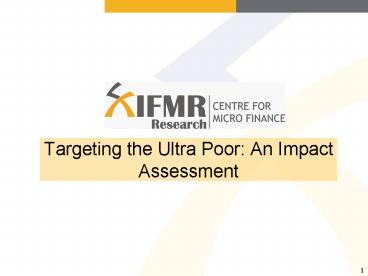Targeting the Ultra Poor: An Impact Assessment - PowerPoint PPT Presentation
1 / 13
Title:
Targeting the Ultra Poor: An Impact Assessment
Description:
Targeting the Ultra Poor: An Impact Assessment * Study Background: Graduation Model Graduation model based on Challenging the Frontiers of Poverty ... – PowerPoint PPT presentation
Number of Views:80
Avg rating:3.0/5.0
Title: Targeting the Ultra Poor: An Impact Assessment
1
Targeting the Ultra Poor An Impact Assessment
2
Study Background Graduation Model
- Graduation model based on Challenging the
Frontiers of Poverty Reduction-Targeting the
Ultra Poor (CFPR-TUP) program pioneered by BRAC - Model being replicated and evaluated
(orchestrated by CGAP and the Ford Foundation in
partnership with local organizations) in 9
locations - Ethiopia, Haiti, Honduras, Pakistan, Peru, Yemen
and India in three places (with Bandhan, SKS, and
Trickle Up)
3
Overview
- Program Objective (Bandhan)
- To provide free income generating assets,
training, and other assistance to help ultra poor
households secure a regular source of income, and
to graduate them to potential microfinance
clients. - Study Objective (CMF)
- CMFs study looks to measure the impact of this
program in 3 blocks of Murshidabad district in
West Bengal. - Is Bandhans THP program resulting in an
improvement of socio-economic conditions for
these ultra poor households?
4
Program and Intervention Design
- Aim graduate the poorest of the poor to
microfinance - Treatment households get to choose an income
generating asset, and receive an allowance for
30-45 weeks depending on the asset selected - Types of assets include livestock such as cows,
goats, pigs, or a combination of these, as well
as non-farm enterprises. - In approximately 18 months after receiving the
asset and successfully retaining it,
beneficiaries receive graduation training
5
Major findings
- Consumption
- Increase in food consumption for treatment group
- mean difference of Rs. 64 per person per month
- Incomes
- Treatment Household income/per person increased
by Rs 78/month (22) over control.
6
Major findings
- Time Use
- Adults in treatment households work more hours
per day, on average, than adults in control
households
7
Additional findings Non monetary transfers and
financial indicators
- transfers / crowd out
- treatment gives approximately 1 more meal per
month (10 of mean) to other households - receive 50 less food gifts than control (Rs. 13
vs Rs. 30 per month) - financial variables
- no effect on credit (increased interest in
borrowing) - increased formal savings (through Bandhan), not
necessarily increased total savings
8
Additional Findings Financial Behaviour and
Confidence
- Treatment households appear to borrow less from
formal and informal sources, but the finding is
not statistically significant. - Households score higher on an index of financial
autonomy (can women take decisions on
assets/operating savings accounts/household
spending decisions) - Households express higher confidence in their
ability to take loans and join savings groups - Possibly affected by survey connection with
Bandhan
9
Findings Food Security
- Treatment households report lower food insecurity
than control households - Adults less likely to skip meals
- Households are 7 more likely to report that they
eat enough every day - Treatment households show higher self-perception
of their household situation
10
Cost Benefit Analysis
- Cost 331/beneficiary household
- Monetary benefit estimated to be an income gain
of 90/household/year - Will these gains persist over time?
11
Conclusion
- positive effects 18 months after asset transfer
- on consumption
- other measures of well being (food security,
emotional health) - non-agricultural enterprises appear important in
income generation
12
Open Questions
- Scale up from 3000 households to entire
districts. - The role of monitoring and continual handholding
and feedback - Can state governments and livelihood missions
adopt some form of the program?
13
Research Team
- Dr. Abhijit Banerjee, Dr. Esther Duflo, Dr.
Jeremy Shapiro (MIT/JPAL) - Dr. Raghabendra Chattopadhyay (IIM-C)
- Sudha Kant, Lakshmi Krishnan, Jyoti Mukhopadhyay,
Abhay Agarwal, Deeptha Umpapathy, Projjal Saha
(Centre for Microfinance)

